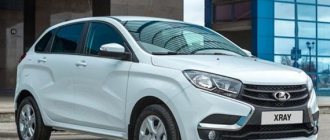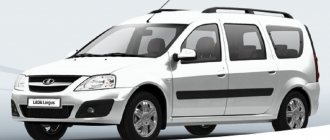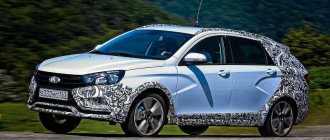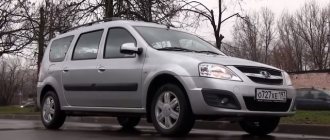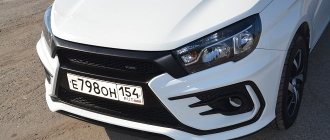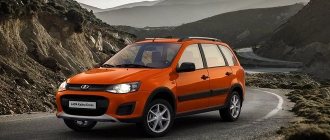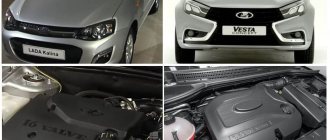Comparing Lifan Maiwei or Lada Largus Cross seems, at first glance, a little strange, since the cars belong to different classes. But in fact, the crossover and station wagon have similar characteristics and can be used as a family car. Which one is better?
Lifan Mayway 2020
By 2022, both cars have undergone an update, despite the fact that the models are relatively new. The Chinese crossover has become more modern and technically equipped. And the Russian station wagon received increased ground clearance and more advanced equipment. In addition, its engine was significantly improved. Both vehicles can accommodate up to seven passengers. They have a fairly spacious interior with many useful options. The machines are equipped with many advanced systems to ensure safety and comfort. However, they differ in the type of drive. They also have some differences in power and fuel consumption. Lada is available only with a manual transmission, and Lifan buyers have a choice of transmission.
Specifications
The dimensions of Lifan Myway and Lada Largus Cross are very similar. The length/width/height of the first is 4440/1760/1730 mm, and the second is 4470/1756/1682 mm. The crossover is only slightly shorter than the station wagon, but at the same time slightly taller and wider. These differences are practically invisible to the eye.
Also, the cars have almost the same ground clearance. The first has 192 mm, and the second, after the latest update, has 195 mm. Thus, they have very good maneuverability.
Both cars, even in the most inexpensive configuration, are well equipped. They have all the necessary systems to provide modern comfort and safety. These devices are reliable. They are well time-tested and perfectly tuned. Even the owners of more expensive cars can envy the equipment of the maximum configurations. And this despite the fact that the Chinese and Russians belong to the budget class.
LADA Priora station wagon
For LADA fans, we have an idea - to buy a Priora station wagon instead of the Largus. The trunk is smaller than that of the hero of our material - 444 liters; passengers will also have less space. But the Priora is more dynamic and comfortable, if these adjectives can even be used in the same sentence with LADA cars. The Priora's configurations are richer, and the average cost is almost half as low - 230 thousand rubles.
It is for this reason that the model is in constant high demand. In the last quarter, 78,138 reports were ordered for it. However, every second Priora was damaged. Every third car had incorrect mileage and had unpaid fines. Only every third car was sold without problems.
There is no need to talk about the reliability of Priora: both cars leave the factory unfinished, noisy and unsafe. But there is almost nothing to break in them, and for urgent repairs a screwdriver and electrical tape will be enough.
Also read: Review of used Lada Priora: is it worth buying
Engines and transmission
Both cars are available with only one type of petrol engine. Lifan Maiwei has the following data:
- volume 1.8 liters, power 125 hp.
And the Lada Largus Cross engine:
- volume 1.6 l, power 106 hp.
Thus, Chinese cars are somewhat more powerful than domestic ones. But at the same time it has lower fuel consumption. In the combined cycle it is approximately 7.6 liters. The second car in this mode consumes about 9 liters of gasoline. The engine of the Russian station wagon was slightly modified and became more reliable. Now, if the timing belt breaks, the likelihood of damage to the power unit is virtually eliminated. But his opponent’s engine is also quite reliable.
Myway can be purchased with both manual and automatic transmissions, while the second car is available only with manual transmission. The first car has rear-wheel drive, which is a bit unusual for most modern crossovers. And its rival is available with front-wheel drive.
Skoda Roomster
Many call this car a “bloated” Fabia. Indeed, Roomster and Fabia are related cars that are created on the same platform. There was only one generation of the Skoda Roomster, produced from 2006 to 2015. However, a sufficient number of copies have been collected, which allows you to choose from used cars available on the market. A spacious trunk, quite comfortable fit and ride, good driving performance - all this was able to fit into the back of a small Czech station wagon.
The roomster was equipped with a wide range of engines and gearboxes and their combinations. The Skoda Roomster could have a naturally aspirated petrol or diesel engine from 1.2 to 1.9 liters, with a manual, automatic or robotic option. You can easily find a runaway Roomster, but you have to try really hard. Very rare options will cost above 500 thousand rubles on Drome, but mostly it is 350-400 thousand.
Recommendations when choosing - stick to gasoline engines and avoid DSG in all its forms.
Ride quality, maneuverability and handling
The Chinese car is equipped with MacPherson strut suspension at the front and a dependent suspension at the rear. The Russian one has the same suspension at the front as its rival, and semi-independent at the rear. In both cases, this unit has good settings and reliability.
The vehicles have excellent handling and maneuverability. You feel confident on them on any road conditions with different surfaces. Even when driving at very high speeds, you don’t feel any discomfort or fear, thanks to precise steering, good suspension and electronic assistants.
The crossover and station wagon feel equally good both in the city and on the highway, as well as on bad roads. Of course, the first car accelerates a little faster than the second and seems more maneuverable. But Largus also has enough power for quick acceleration or overtaking.
Lada and Lifan cope well with uneven roads and minor off-road conditions. Therefore, they are great for trips to the country or to nature.
Comparison of characteristics for basic configurations
| Characteristics | Lifan Myway (1.8 MT Comfort) | Lada Largus_cross (1.6 MT Luxe 7 seats) |
| Drive unit | Rear | Front |
| Body type | SUV | Station wagon |
| Transmission | Mechanics (5) | Mechanics (5) |
| Engine volume, l | 1.79 | 1.6 |
| Ground clearance, cm | 19.2 | 19.5 |
| Max. speed, km/h | 160 | 165 |
| Length, cm | 444 | 447 |
| Width, cm | 176 | 447 |
| Height, cm | 173 | 447 |
| Total seats | 7 | 7 |
| Weight, tons | 1.44 | 1.33 |
| Max. power, hp | 125 at 5600 rpm. | 106 at 5800 rpm. |
| Max. torque, N*m | 168 at 4200 rpm. | 148 at 4200 rpm. |
| Type of power plant (motor) | In-line, 4-cylinder | In-line, 4-cylinder |
| Fuel | AI-95 | AI-92 |
| Supercharger | No | No |
Comparison of configurations and prices
Lifan Myway is sold on the Russian market in three trim levels. They differ in the type of transmission and set of options. Even in the minimal version the car is well equipped. Moreover, in this version it costs about 870,000 rubles. The second car is available in two versions, with slightly different equipment and number of seats. The cheapest equipment of the Russian costs at least 750,000 rubles, which is somewhat cheaper than the Chinese. At the same time, the second car is almost as functional as the first.
Fiat doblo
Fiat Doblo Panorama in 2022 became the sales leader among all representatives of its segment. The price of the car starts at 575,000 rubles. The car is equipped with a 77 hp gasoline engine. and a five-speed gearbox. The car's configurations are quite limited; the most important positive quality of the car is, undoubtedly, its spaciousness.
The car's carrying capacity reaches 700 kilograms, and the trunk volume starts at 750 liters and reaches 3000 liters with the rear seats folded. The car is equipped with a sliding door at the rear right. For an additional fee you can order the same one on the left.
New Lada: How to remove a Kalina generator 16 valves with air conditioning without a pit
The cargo version of Doblo Cargo is capable of transporting 750 kilograms, and when ordering an option that increases the carrying capacity - 850. The trunk volume reaches 3.2 cubic meters. This version in an all-metal case is sold at a minimum price of 545,000 rubles. Additional payment will be required for the left cargo door, air conditioning and audio system.
Maintenance costs
Servicing a crossover and station wagon costs about the same. Spare parts for both cars are inexpensive. But in the first case, there may be some delays in delivery from China. True, they are usually insignificant. In the event of a malfunction, repairing the first car will be as affordable as the second.
Lifan MyWay configurations and prices
| Equipment | Engine | Volume, l | Power, hp | checkpoint | Drive unit | Acceleration to 100 km/h, c. | Max. speed, km/h | Consumption per 100 km, l | Price, rub. |
| 1.8MT Comfort | petrol | 1.79 | 125 | Mechanics | rear | — | 160 | — / 7.1 | 898 900 |
| 1.8MT Luxury+ | petrol | 1.79 | 125 | Mechanics | rear | — | 160 | — / 7.1 | 958 900 |
| 1.8 AT Luxury+ | petrol | 1.79 | 125 | machine | rear | — | 160 | — / 7.1 | 1 018 900 |
Largus Cross configurations and prices
| Equipment | Engine | Volume, l | Power, hp | checkpoint | Drive unit | Acceleration to 100 km/h, c. | Max. speed, km/h | Consumption per 100 km, l | Price, rub. |
| 1.6 MT Luxe 7 seats | petrol | 1.6 | 106 | Mechanics | front | 13.5 | 165 | 11.6 / 7.6 / 9.1 | 773 900 |
| 1.6 CNG MT Luxe 5 seats | gas, gasoline | 1.6 | 106 | Mechanics | front | 13.5 | 165 | 11.6 / 7.6 / 9.1 | 937 900 |
* — information on prices is for reference only. Check with your local dealer for exact pricing.
Toyota Verso
The Japanese compact van Toyota Verso based on the Corolla was sold in Russia from 2022 to 2022. This model is praised for its high reliability: sudden breakdowns are rare even at high mileage, which is confirmed by car owners on specialized forums.
On the secondary market, for the specified amount, you can get an option with a mileage of about 100,000 km. Of the modifications, you can choose a car with a 1.6-liter engine (132 hp) and manual transmission, or with a 1.8-liter engine (147 hp) and an Aisin K311 CVT.
In the first case, Verso will be 7 or 8 years old, and in the second - 9 or 10. One way or another, the units of both modifications are reliable and capable of plowing more than 200,000 kilometers without any problems.
Among the expressed shortcomings of the model, it is worth noting the rather controversial ergonomics of the interior with a small number of pockets and drawers for small things, plus the weak sound insulation can disappoint.
Appearance, dimensions
Externally, the cars are similar, except for their size. Otherwise they look completely different. Each of them has a unique and recognizable appearance. The only thing that Lifan Maiwei and Lada Largus Cross have in common is that their body is protected by a special black plastic body kit.
The Chinese car looks like a real stylish and modern crossover with streamlined, fashionable shapes. Its front seems quite voluminous and massive. It attracts attention with the presence of chrome decorative elements on the radiator grille and bumper. The rather large chrome brand emblem also stands out.
From the side, the crossover also looks quite massive. Its wheel arches are very large, despite the fact that it is recommended to use 16 or 17 radius wheels. Branded wheels have an expressive and recognizable design. At the bottom of the doors there are black plastic moldings.
The rear of the car attracts attention with its relatively small but unusually shaped lights. At the edges of the rear bumper there are chrome exhaust pipes. The Lifan trunk is also decorated with a chrome strip.
The Russian station wagon looks simpler and more ascetic compared to its rival. It seems like such a workhorse, but not without a hint of style. A modern and interesting look is given to it by an unpainted plastic body kit around the entire perimeter of the body.
The car seems square. This is especially noticeable when viewed from the side or behind. And from the front, the Largus Cross attracts attention with the only chrome elements on the entire body – a stripe on the radiator grille and the manufacturer’s emblem. After the update, the station wagon received headlights of a more interesting and stylish shape and of a rather large size.
From the side, the Lada Largus Cross stands out with its rather large windows. But the side mirrors, unlike the opponent’s, are small, which may somewhat limit the view. They also do not have turn signal repeaters, which the Chinese have. Also noteworthy are the black plastic door moldings. The Russian is equipped with 16-radius wheels of a recognizable and fairly simple shape.
The rear of the car has a square shape. The Lada has a rather large trunk door, also trimmed with an unpainted plastic strip. The taillights are small and have a fairly simple elongated shape.
If Lifan is a real dude, then Lada is a simple and inconspicuous option for work and life.
Salon and trunk
The interior of each car is made in a two-tone version. Quite high-quality materials were used for finishing: plastic, leather and fabric. Maiway, according to many experts and owners, seems more spacious. Although, the Lada Largus Cross has enough space both front and rear. True, for a large family you will need a seven-seater option. But, in this case, you will have to sacrifice the volume of the luggage compartment. In addition, the station wagon is also sold in a five-seater version without a third row of rear seats.
The dashboard in both cases is made of high-quality plastic. The Chinese have a more modern look, thanks to the rectangular shape of the deflectors and a more advanced design of buttons and function control keys. The Russian has somewhat outdated round deflectors and fairly simple buttons for controlling functionality, which in both cases are located under the audio system.
The Chinese car is equipped with a full-fledged modern multimedia system with a large touch screen and luxurious functionality. Its sound is also at a quite decent level. Domestic cars have a conventional sound system with a minimal set of functions and a small display. It sounds good, but it won't be enough for true music connoisseurs. There is no talk of any navigators or other options. However, this drawback can easily be corrected by the owner by purchasing suitable multimedia.
The Chinese steering wheel is multimedia, medium-sized and very comfortable. The steering wheel of a domestic car is also quite informative and comfortable, but there are no “music” control keys.
It is not easy to understand which is better - Lifan Maiway or Lada Largus Cross in terms of the quality of the seats, since in both cases they are covered with high-quality materials, are comfortable and have good lateral support. The seats have a sufficient number of settings and adjustments.
Myway has a good trunk volume for a seven-seater car - 295 liters. Of course, you can only put the most necessary things in it. And, if you need to transport large cargo, you will have to sacrifice the last row of rear seats. The station wagon from Russia has more modest luggage compartment volumes - 135 liters. Therefore, if the buyer plans to transport a lot of things, then it is worth considering a five-seater option or folding the last row of seats. This way there will be more space.
What's good for a Russian: a detailed test of the Lada Largus Cross - read in the tests section in the Avto.ru magazine
In recent years, AvtoVAZ has become quite good at inventing new market niches and quickly occupying them at minimal cost.
For example, the “sports budget employees” Kalina Sport and Granta Sport were once joined by the Drive Active version, which has just gone through restyling. We recently drove it, and the main thing you need to know is: here and now this is the most affordable way to add at least a little sport to your car without resorting to “tuning” from South Port. And here is an even more striking example - a cross-version of the Lada Largus station wagon, one of the first new products released under Bo Andersson. And if the pedigree of the aforementioned Granta Drive Active is purely Russian, then Largus Cross is a true citizen of the world. The French came up with a station wagon based on Logan and gave it to the Romanians, who then sent the Dacia Logan MCV to AvtoVAZ, which... replaced the Renault engines with their own and put the model on the assembly line under the name Lada Largus.
And then the car, which was already well suited to our conditions, was raised above the ground, dressed in a body kit made of unpainted plastic - and... it turned out to be an ideal car for Russia. Large and unpretentious. But is Largus Cross so ideal?
Which is better to choose?
Despite the fact that the machines have similar characteristics and dimensions, the question of choice in this case will be quite simple. Here you need to proceed from your own wishes and preferences.
Lifan is ideal for young drivers and people who appreciate modern design and style. It is perfect for fans of fast driving and those who need to transport cargo and passengers. The car is an excellent option for a large young family with small children. It is suitable for both city trips and travel. The Chinese can easily cope with off-road conditions. And the option with automatic transmission will definitely be appreciated by many female drivers.
Lada does not have impressive speed data. It is more suitable for calm or middle-aged drivers. This car is unlikely to impress girls. She's more masculine. Largus can also be used as a family car. It is also suitable as a workhorse or for trips to the country. But in this case, you will most likely have to go with the five-seater version to get a more spacious trunk.
The Chinese and Russian are quite reliable. With proper care, they can serve for a long time without failure.
If you want to save money, Largus Cross is perfect, and if you need a modern stylish design and crossover, then you should go for Lifan. In addition, its interesting advantage is the ability to start the engine using a button, which is very rare in budget cars and is typical for the premium class.
Other options
An excellent alternative to those who for some reason were not impressed by either the Chinese or the Russian will be the French Renault Duster. It costs about the same as the Lada Largus, but is also sold in an all-wheel drive version. It also has a choice of transmissions. This machine has an interesting design and many useful functions. Almost a real SUV, especially when equipped with all-wheel drive. Renault is trouble-free and reliable.
Choosing a “heel”: does Largus have any competitors?
Let's compare the new Renault Dokker with its main competitors on the market: Lada Largus and Volkswagen Caddy.
Renault Dokker 1.5 dCi
Length / width / height / base: 4363 / 1751 / 1814 / 2810 mm Trunk volume (VDA): 800–3000 l Curb weight: 1334–1395 kg Engine: diesel, P4, 8 valves, 1461 cm³; 66 kW / 90 hp at 3750 rpm; 200 Nm at 1750 rpm Acceleration time, 0–100 km/h: 13.9 s Maximum speed: 162 km/h Fuel / fuel reserve: diesel / 50 l Fuel consumption, combined cycle: 5.1 l/ 100 km Transmission: front-wheel drive; M5
Is this a "heel"? More like a wedge heel! But not in the “small tank” sense, but in the shoe aspect. If anyone doesn’t remember, the IZH-2715 passenger van was called “heel” because of the stepped shape of its body, due to the all-metal booth that rose behind the driver’s cab. Subsequently, this nickname spread to other cars of this type - including those that look much less “heeled”. Among them are Peugeot Partner and Citroen Berlingo. And also Renault Dokker, which came to Russia at the end of last year.
Solid Morocco
On a global scale, Dokker is not new. As a girl, this vehicle under the original Romanian name Dacia Dokker marked its debut in 2012 at the Casablanca Motor Show. This is in Morocco. There, the French built another plant, spending $1.3 billion on it; one plant in Casablanca was not enough for them. Moreover, it was necessary to locate somewhere the production of the Lodgy minivan, from which, in fact, the Dokker was subsequently fashioned. We are supplied with Moroccan Dockers. Several years ago, the French seriously thought about producing Docker in Russia, but you know how the circumstances turned out.
The “heel” is based on the modernized B0 platform, on which the entire Dacia model range is built a little more than completely. Nurse, may God grant her good health. In Europe, you can choose from four powertrains, but only half of them are addressed to us. A good half? Perhaps yes: the 1.6‑liter naturally aspirated K7M petrol engine with a power of 82 horsepower will be clearly preferable for us to the more powerful (115 hp) 1.2-liter turbo engine. And of the two turbodiesel K9Ks, we got the full-power version with 90 “horses” - “75 horsepower” is not brought to Russia.
The finishing materials are simple, but quite consistent with expectations. In a simpler configuration, the interior looks a little poorer, but this does not spoil the impression of the car.
Devices are from Logan. Tachometer digitization is universal for gasoline and diesel versions. Sooner or later you get used to the audio system control panel located on the steering column, but it would still be more logical to move the keys to the steering wheel spokes - instead of cruise control.
Acting
In the model line of the Russian Renault, the recruited Dokker is intended to fill the vacuum left by the retired Kangoo, which was not particularly successful. Maybe it's all about the format? Peugeot Partner and Citroen Berlingo also did not sell very well, and the Volkswagen Caddy did not particularly shine. The expensive Mercedes-Benz Citan was a complete failure: the Kangoo analogue with a star on its forehead received only nine buyers in the first three months of 2022.
What a difference, dear Largus! Three thousand vehicles are sold every month - about 2,500 passenger versions and 600 cargo vans. This, of course, is not the pinnacle of technical progress, everything is decided by the price: from 470 thousand rubles for a solid van and from 530 thousand for a passenger Largus.
The diesel Dokker we took for testing in the top Drive version and with a full range of options cost 1,103,930 rubles - for this money you can buy two Largus! Or you can look for something more impressive on the secondary market, for example, a Volkswagen Caddy. Yes, not simple, but with pleasant complications. Like our editorial car - with a 2-liter diesel engine, all-wheel drive and an extended wheelbase. One hundred thousand kilometers for a German “commerce” is not a mileage.
On the mezzanine it is convenient to store all sorts of small things or, say, documents - the glove box is too small for this. The passenger even has a makeup mirror (though not illuminated). Three passengers can easily sit on the bench-like rear sofa, since there is practically no central tunnel.
We only dream of comfort
On the Renault website, the Dokker is listed in two sections - it is both a passenger car and a commercial vehicle. Moreover, Renault acts as a “merchant” in two guises at once: in the passenger version and as a purely cargo Dokker Van with blank sides.
The passenger version should be considered a family vehicle. But will you want to? I am sure that not every head of a family is able to discern a passenger car in Docker. Yes, there is a second row of seats with access through sliding doors (the right one comes as standard, you have to pay extra for the left one). But the opening mechanism and the amount of space in the cabin do not turn the “heel” into a minivan: you won’t get much comfort.
Being a passenger car in fact, Renault remains commercial in essence. It's like a bus: it's better to go poorly than to go well. Although no, this is still personal transport, not public transport, which in itself is not bad. Meanwhile, nowadays not every bus has an interior that boasts bare metal, sparingly covered with paint. I miss the comfort of Docker. Or rather, it will probably be enough for me in the driver’s seat, but my family is unlikely to appreciate the asceticism of the back row.
Each of the rear seats is equipped with Isofix. Let the children get used to restraint from childhood! Tightly strapped into a child's seat, they won't learn until they're fully grown that adults in Docker have nothing to hold on to. It's a pity: the sofa is flat, but there is not a single handrail within reach - not even the handles on the doors. The trim of the sliding doors has no pockets, and the windows do not roll down; they can only be slightly protruded outward in the hope of an influx of fresh air.
The space in the back is magical, even if this is not the main virtue of a family car. The three of you can easily sit down: the sofa is shaped like a bench, only soft. And the floor is almost flat: the central tunnel is nothing more than a convention.
The front seats are set high enough to fit your feet under them even with bulky winter boots.
Renault Dokker is available with a body in a single version. The VW Caddy can be selected with an extended wheelbase, and a couple of Citroen Berlingo/Peugeot Partners can be selected with an increased rear overhang. There will be no roof rails on the Docker roof in the basic configuration - this is the prerogative of the most expensive Drive version. For alloy wheels you need to pay an additional 9990 rubles.
Double standard
The trunk door is divided into two unequal parts, which open alternately: the larger “half” has priority. This is a purely commercial story. As well as the ability to “re-open” the door beyond the limiters, turning each leaf 180 degrees relative to its original position. In this situation, it will be possible to drive close to the loading site. Parking sensors with three sensors will help you.
By default, the trunk volume is 800 liters (under the curtain), but if you extend it into the cabin by folding the sofa like a sandwich and placing it vertically, the volume of usable space will increase to three cubic meters. On a van, by the way, you can also sacrifice a passenger seat, receiving an additional 900 liters along with the ability to transport long items up to 3.1 meters - however, a folding seat, coupled with a transformable partition, goes through the list of options and costs a considerable 25 thousand rubles. Both the cargo version and the passenger version will give you a reason to rejoice at the low loading height (570 mm) and the flat floor.
Docker's commercial essence is revealed in the zonality of the inner world. Because from the point of view of the driver and navigator (or forwarder?), the front part of the car is perceived as quite passenger car. Tidy from Logan; good seats, although lacking lateral support; controls familiar to most renovators with characteristic layout flaws - everything is familiar here. There is no point in talking about Docker's shortcomings: they are completely inherited from relatives with the B0 chromosome. Cruise control buttons scattered in an ergonomic explosion; clumsy double-armed heating keys carelessly thrown into the bases of the chairs; The audio control panel on the steering column requires some getting used to - that's what Renault is all about. Do you know how to get rid of this? That's right - choose a package without any frills. And thereby not spoil the car at all.
Because its main advantage, no matter how trivial it may be, comes down to the very practicality with which every cubic centimeter of the bloated internal space is imbued. Maximum usable area with minimal dimensions. That's why all this was actually conceived. The machine uses itself to the fullest - and generously shares its length, width and height. This is captivating.
The rear sliding door windows do not roll down, but the windows can be opened slightly.
Anti-greed
Generosity is perhaps Docker's defining characteristic. He doesn't have much, but he will gladly share everything he has. Dieselek with 90 forces pulls at one hundred percent - both percent and strength. Docker clearly likes to show off the traction he has. Gear changes are not intoxicating with weapon-like precision, but they also do not irritate with problematic selectivity: you can’t go wrong.
Brakes? As they say now, it’s normal.
The steering wheel is just right: light, but extremely understandable. Many cars would be half to death jealous. But the ride comfort has a cargo scent. The Dokker goes over uneven surfaces springily, but not skipping, although sometimes it seems that even on a smooth road it continually begins to fix the microrelief of the asphalt, slightly using the springs to play out the smooth surface. You manage to pay attention to this, but there is still not enough fuse for irritation.
The new Largus is ready to become a budget alternative to Docker. And among used cars, you can also look for more thoroughbred equipment.
Edits for context
How relevant is Renault Dokker to Russian reality? Let's go in order. Family car? I guess not: functionality does not make up for the lack of comfort. This car doesn't just look utilitarian - it is utilitarian. This is both a sentence and a compliment at the same time. Carrying cement with manure is a pity for a car, but transporting children is a pity for children. However, there will certainly be lovers of deliberate practicality.
As a van, the Dokker must be good, but for this it must be with the Van prefix: no windows, no seats, no people. And as cheaply as possible. A sliding door on the left side is not needed, and other goodies too. But without “music” it will be sad, and without air conditioning it will be sad: in the summer, an all-metal van heats up instantly, but cools down reluctantly.
A passenger “heel” can be useful as a second car - but only if you clearly know what to do with it. Bicycles, camping equipment... Maybe a pit bike, after all. Taxi, by the way. An excellent role for Docker, that's for sure. In Turkey, locally assembled Fiat Doblo is actively used for this purpose. And let us have a Renault Dokker, albeit a Moroccan one. Russian would be better, of course. But what if?
DOKKER VS…
We did not set ourselves the goal of pitting Docker against his rivals in a comparative test, but still grabbed cars that could well serve as a context for the “Frenchman.” The tasks they face are often the same, and varied: to transport the family, to go to the construction market, and to go to the dacha.
We used the editorial long-wheelbase Volkswagen Caddy as a standard.
Volkswagen Caddy (long wheelbase)
This is the quintessence of functionality: it is the most spacious, the most comfortable, the most gifted - all-wheel drive! And the most expensive, of course: a new car with a similar specification costs about two million, and the simplest passenger front-wheel drive “shoe” will cost 1,380,700 rubles.
At the other pole is the people's favorite Largus. Our editorial station wagon in the Luxe version would now cost 665,400 rubles - significantly cheaper than the Renault Dokker. Is it as much worse as it is cheaper?
Lada Largus
In order to get the spare tire, you don’t need to unload the trunk: the full-size spare wheel hangs under the bottom. The gate leaves open at a right angle, but this angle can be increased by another 90 degrees if the latches are released.
If it is customary to measure a boa constrictor in parrots, then for Docker and his comrades we chose tires as the units of measurement. But they didn’t completely fill the trunk with rubber. To begin with, we assessed the headroom by stacking the tires; and then placed them vertically in a row, estimating the width of the cargo compartment.
Four tires measuring 205/55 R16 easily fit into all three cars - this way and that. Then we took out another set from the bins, but a little smaller - 185/65 R15.
Largus refused to accommodate the fifth wheel across the trunk, but we were able to push it right up to the ceiling, laying the tires flat - for this we had to bring the tire through the side door.
Five wheels easily fit into the Dokker both in height and width.
We placed the same number of tires (but with a larger margin) across the trunk of the Caddy, and the height included six tires. Record!
True, common sense dictates that in any case it is economically feasible to take a slightly tighter Largus rather than overpay for more expensive equipment.
The Lada does not have a diesel engine or sliding doors, but the price outweighs all the shortcomings. Or not all?
Author: Brevdo Kirill
Video
Comparison of basic configurations
| Function | Lifan Myway (1.8 MT Comfort) | Lada Largus_cross (1.6 MT Luxe 7 seats) |
| Front-camera | ✔ | No |
| Steering column, adjustable | ✔ | ✔ |
| Anti-lock system (ABS) | ✔ | ✔ |
| Drive of the 1st row of seats, electric | No | No |
| Driver's seat drive, electric | No | No |
| Stability Control (ESP) | ✔ | No |
| Electronic Brake Force Distribution (EBD) | ✔ | ✔ |
| LED daytime running lights | ✔ | No |
| Heated 1st row of seats, electric | ✔ | ✔ |
| Leather interior | ✔ | No |
| Front parking sensors | No | No |
| Climate control (climate control) | ✔ | No |
| LED rear lights | ✔ | No |
| central locking | ✔ | ✔ |
| EUR (steering) | ✔ | No |
| Heated side mirrors | ✔ | ✔ |
| Keyless entry into the car | No | No |
| Rear parking sensors | ✔ | ✔ |
